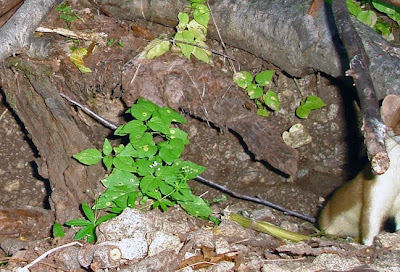I finally got it: I
cam-trapped a weasel in its dashing white winter camo.
But as you’ve noticed, it’s sticking out like a sore thumb
because there’s no snow 2 feet underground where the picture was taken.
I’ve wanted that photo since I learned that weasels are
frequent but uninvited guests in mountain beaver tunnels.
Wouldn’t it be cool to show a winter weasel without the
benefit of its winter backdrop of snow?
How do you get that picture?
You can nature-fake it – just live trap a weasel (no small
feat) and photograph it on soil and leaf litter set in a cage.
Or you can set a camera in a mountain beaver burrow.
But there’s risk and a technical challenge to leaving a
camera underground in a rodent burrow for half a year.
You have to supplement the camera’s normal battery power so
it can take flash photos for 6 months. (I wired 4 external batteries -- 2 D and
2 C cells -- to the camera for back up power, and used 2 9-volt batteries to
power the controller.)
And you have to retrieve your camera before spring snowmelt
floods the burrow and drowns the camera or buries it in silt.
I was ready to deploy in the fall of 2013, but procrastinated,
and the snow shut me out that winter.
I procrastinated again in 2014, but it was a drought year,
and I got away with setting the camera in early November.
Disappointment came the following May when I discovered the
batteries died 45 days into the bargain and before any weasel made an
appearance. Murphy’s Law.
Last winter I had the camera in the ground on October 7th.
The camera had been out 8 months when I drove to the site a
couple weeks ago with Bill and Diane Wilson.
Our timing seemed okay. The snow was gone at 6000 feet, and
the Forest Service road was dry. The
only thing that was worrisome was the Yuba River, which was already roaring
from snowmelt.
At 7000 feet snowdrifts blocked the road.
“Wait here Bill, I think it’s within walking distance.”
I skirted the drifts on the road, but it was solid snow at
the creek, which was a choppy gusher.
This was not a good sign because the camera was in an alder
thicket on a silt bench a few yards from the creek and only a few feet above
water in summer.
A few minutes later I found the alder thicket; normally 8-15
feet high, it was flattened by snowpack.
I’m standing there thinking it would take a team with
shovels and spuds to expose the camera, when I see a bare spot and a piece of weathered
plywood.
It was the cover over the tunnel and camera.
I tugged it free like a crazed treasure hunter . . . and “Damn
(expletives deleted)!”
The tunnel was flooded.
I yanked the stake free with the camera attached . . . and “DAMN!
(more expletives deleted)!”
Rust-colored water
drained from the camera case.
I pulled the precious SD card, dried it, and headed back to
the car with the dripping camera trap.
At San Francisco State University’s field campus we downloaded
the file.
The camera took 106 photos before unseasonal rain flooded
the burrow at the end of January.
I was resigned to another failure as we scrolled through
blank exposures and occasional pictures of vole, shrew, or chickaree.
Then the snow-white weasel appeared. On January 7th.
One image.
It was the last animal picture on the card.
Three weeks before the flood that ruined the camera.











































